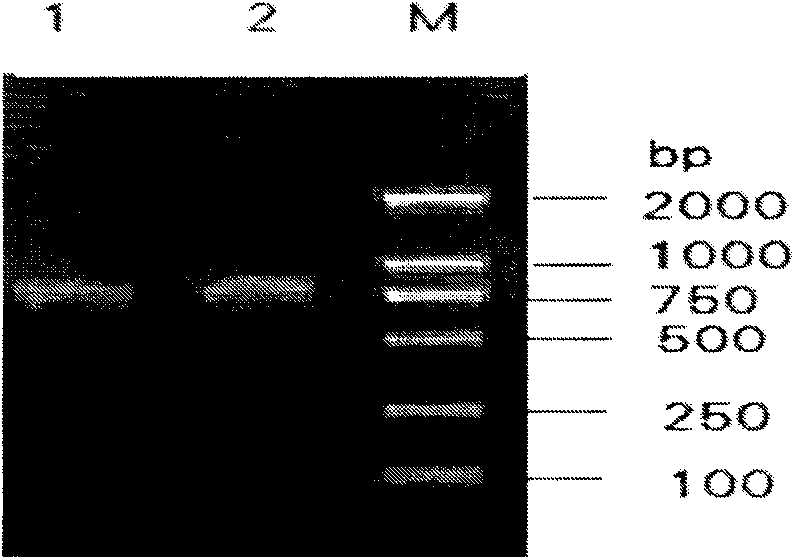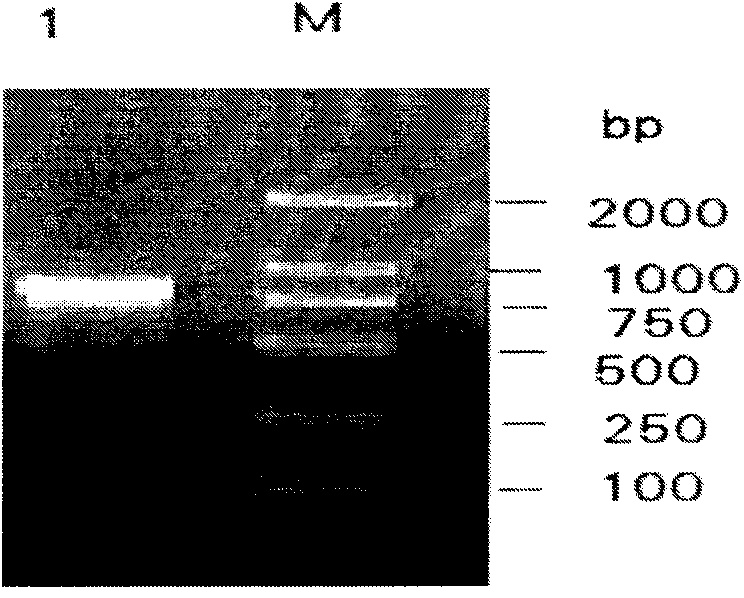Method for detecting infectious bovine rhinotracheitis virus and application thereof
The technology of a rhinotracheitis virus and a detection method is applied in the detection of viral infectious diseases and the detection of bovine infectious rhinotracheitis virus, and can solve the problems of inability to correctly determine the copy number of a target gene, false negatives, and reduced sensitivity, etc. To achieve the effect of short detection time, convenient operation and high sensitivity
- Summary
- Abstract
- Description
- Claims
- Application Information
AI Technical Summary
Problems solved by technology
Method used
Image
Examples
Embodiment 1
[0068] Embodiment one: detection of bovine infectious rhinotracheitis virus
[0069] 1. Design and synthesis of primers and probes:
[0070] According to the BHV-1gB gene sequence, specific primers Ip2, Ir2 and fluorescent probe ITpro of 141 bp were amplified, and primers Ip1 and Ir1 were constructed as templates, in which Ip1 and Ir1 were located outside Ip2 and Ir2, and a fragment with a length of 787 bp was amplified. The probe ITpro sequence was rearranged, primers Ic1 and Ic2 were designed, and the internal standard probe ICpro was constructed by using the principle of base mutation and the artificially added linker sequence.
[0071] 2. Preparation of target DNA template:
[0072] BHV-1 was propagated by cell culture, and after freezing and thawing, the supernatant was taken to extract viral DNA with DNAZo1 extraction solution; the semen was filtered with Sephacryl S-400 gel, and nucleic acid was extracted with DNAZol.
[0073] Viral DNA was used as a template, and Ip1...
Embodiment 2
[0084] Embodiment 2: Obtaining the target template
[0085] BHV-1 was propagated by cell culture, and after freezing and thawing, the supernatant was taken to extract virus DNA with DNAZol extraction solution, and the semen was filtered with Sephacryl S-400 gel, and then nucleic acid was extracted with DNAZol.
[0086] Use viral DNA as a template, use Ip1 and Ir1 as amplification primers for PCR amplification, 20 μL reaction system, in which: Mg 2+ 1.5mmol / L, 0.25mmol / L each dNTP, 1mmol / L each primer, 1.25u Taq DNA polymerase, 5μL template. The amplification conditions were: denaturation at 95°C for 5 minutes; 35 cycles of 96°C for 1 minute, 50°C for 1 minute, and 72°C for 2 minutes; and finally extension at 72°C for 10 minutes. The amplified product was electrophoresed with 1% agarose, purified and recovered by gel, connected to the pMD18-T vector, transformed into DH5α competent cells, and the plasmid was extracted for identification by PCR, enzyme digestion and sequencing....
Embodiment 3
[0091] Embodiment three: the construction of internal standard template
[0092] Using plasmid IT as a template, primers Ip1, Ic1 and Ic2, Ir1 were used as paired primers for PCR amplification, 20 μL reaction system, in which Mg 2+ 1.5mmol / L, 0.25mmol / L each dNTP, 1mmol / L each primer, 1.25u Taq enzyme, 5μl template. The amplification conditions of Ip1 and Ic1 were: 95°C for 5 min; 96°C for 1 min, 56°C for 45 s, 72°C for 45 s, 35 cycles; 72°C for 10 min. The amplification conditions of Ic2 and Ir1 were: 95°C for 5 minutes; 96°C for 1 minute, 62°C for 45s, 72°C for 45s, 35 cycles; 72°C for 10 minutes. Fragments of 227bp and 588bp were amplified respectively, and named Ip1c1 and Ic2r1, see attached Figure 4 .
[0093] Ip1c1 and Ic2r1 were mixed in equal amounts as a template, and PCR amplification was performed with primers Ip1 and Ir1, and the reaction system and amplification conditions were the same as those in Examples 1 and 2. Purify and recover the amplified product an...
PUM
 Login to View More
Login to View More Abstract
Description
Claims
Application Information
 Login to View More
Login to View More - R&D
- Intellectual Property
- Life Sciences
- Materials
- Tech Scout
- Unparalleled Data Quality
- Higher Quality Content
- 60% Fewer Hallucinations
Browse by: Latest US Patents, China's latest patents, Technical Efficacy Thesaurus, Application Domain, Technology Topic, Popular Technical Reports.
© 2025 PatSnap. All rights reserved.Legal|Privacy policy|Modern Slavery Act Transparency Statement|Sitemap|About US| Contact US: help@patsnap.com



